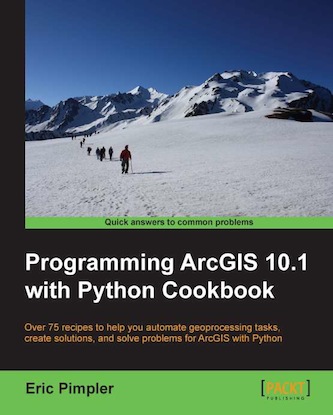Review: Programming ArcGIS 10.1 with Python Cookbook
Summary: A useful guide to automating ArcGIS using Python, which is fully up-to-date with the latest version of ArcGIS. Definitely provides "quick answers to common problems", but it may take more effort to get a deep understanding of the methods used. Good breadth of coverage – but notably lacks raster examples – and well explained throughout. I have recommended to colleagues using ArcGIS who want to start off with Python.

Reference: Pimpler, E., 2013, Programming ArcGIS 10.1 with Python Cookbook, Packt Publishing, 508pp Publishers Link.
I wrote this review in consultation with my wife, Olivia, who has been an ArcGIS user for a few years, but is fairly new to Python programming (she’s done a bit in the last few months, but nothing within ArcGIS). I am more experienced with Python – having released a number of packages to the Python Package Index, and having used Python with ArcGIS in various contexts with both ArcGIS 9.3 and 10.1, but I thought it would be useful to get an opinion from both a more- and less-experienced user.
We both found the book useful, and learnt a lot from it, but weren’t entirely convinced by the cookbook format. In general, if you like cookbook-style books then this is likely to appeal to you, but if they annoy you then you won’t like it. The benefits of the cookbook format are that it is very easy to pick up the book, find the relevant recipe for what you’re trying to achieve, turn to it and do it immediately, as each recipe is almost entirely self-contained. Of course, the disadvantage is learning in this way lends to lead to superficial knowledge rather than deep understanding: you may know what to do to achieve a certain result, but not why you’re doing it, and thus cannot adapt the recipes easily to other situations. Another disadvantage is that the recipes are often very repetitive – for example, each recipe in this book starts with the saying "Import the ArcPy module using import arcpy", and often "import arcpy.da" – something which could be mentioned once and then referred to in future recipes.
Moving away from the cookbook format, which is very much a matter of personal taste, the book covers a wide range of tasks that you can scripts using Python in ArcGIS including interacting with the map window, laying out and printing maps, running geoprocessing operations and accessing the raw data in each layer. The ordering of the book may seem strange to you if you are interested in automating processing operations, rather than automating layout and map style operations, as the geoprocessing part of the book doesn’t start until chapter 6. However, when you get to this section it is very good, and chapters 6 to 9 provide almost all of the information needed to automate geoprocessing tools either using the built-in ArcGIS geoprocessing tools, or by writing your own geoprocessing algorithms using the raw spatial and attribute data.
I was impressed to see coverage of creating ArcGIS Addins using Python in chapter 11, as many ArcGIS experts are not aware of the possibility of creating addins using Python. These addins can provide very user-friendly ways to interact with processes which have been automated in Python, so it is good to see they were covered in this book. I was also pleased to see a chapter on error handling which covers both generic Python error-handling techniques (such as the try-except block) and ArcPy-specific methods, including how to get error messages from ArcGIS into Python. However, there is a noteable absence of any recipes involving raster data – the only exception is in chapter 10 when the use of the Describe() function to find out information about images is explained. However, ArcGIS 10.0 introduced various functions to operate on rasters – including returning the raster data as a numpy array, and allowing updates of raster data from numpy arrays – the coverage of which would really have made the book complete.
In terms of ancilliary information in the book: there is a useful twenty page introduction to the Python language, as well as useful appendices covering automation of Python scripts (using the Windows command-line, and Task Scheduler) and "Five Things Every GIS Programmer Should Know How to Do with Python" (including downloading via FTP, sending emails, and reading various types of files).
The book is generally well-written and formated, and things are explained well – although the quality of the images used is lacking sometimes (with JPEG compression artefacts clearly visible). Overall, the book is a very useful addition to a GIS library for people who are new to automating ArcGIS using Python, and particularly those who want to find out quickly how to automate a particular operation.
If you found this post useful, please consider buying me a coffee.
This post originally appeared on Robin's Blog.
Categorised as: Academic, Books, GIS, Remote Sensing, Reviews
Leave a Reply